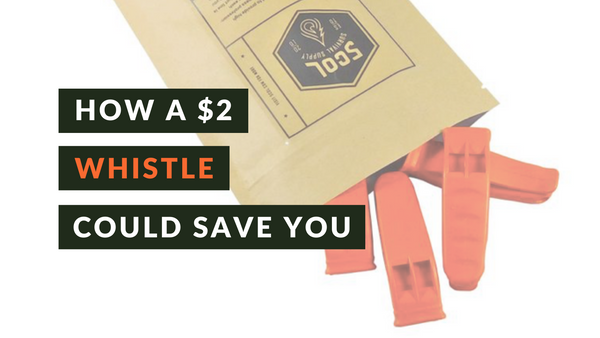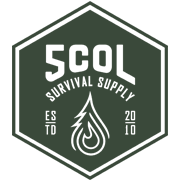
How a $2 Whistle Could Save You
You’re stranded at the bottom of a ravine, injured and barely able to move. There’s no cell service, no bystanders, and no way out.
Too exhausted to yell for help, all you can do is type out goodbye letters and repeatedly blow a whistle, hoping someone will hear it.
You continue blowing it when you hear the buzz of a rescue helicopter flying overhead.
This real-life scenario happened to Amber Kohnhorst, a hiker who fell an estimated 100 feet while traversing an Arizona trail in May of 2016.
It’s cases like hers that keep “safety whistle” on the list of top ten essentials to include in a hiking pack, but safety whistles aren’t exclusive to hikers.
There are several different scenarios in which a whistle could mean the difference between life and death.
Uses for a Safety Whistle
Boating
Any Titanic fans out there may remember a whistle saves Rose’s life. She uses it to signal to a passing lifeboat that she’s alive — her voice too hoarse to scream.
While that’s an extreme scenario, it’s rooted in truth.
When a rogue wave flipped Sean Danielson’s kayak in 2018, two sailors saved him from the frigid Chesapeake Bay after hearing his whistle blasts in the distance. The pair told The Washington Post they thought his green boat was a patch of grass until they heard the noise.
He was hypothermic and barely conscious when they pulled him aboard. Had he not had a whistle, it’s likely they wouldn’t have saved him in time — or at all.
That’s why U.S. Coast Guard requires its members to wear a life jacket with a whistle attached via lanyard. The entity recommends the same for boaters, though only life jackets are federally mandated.
Whistles are louder and carry farther than human voices.
In a situation where you’ve fallen overboard, you’ll likely be competing with other noises — a boat motor, breaking waves, wind, etc. The whistle blast could reach rescuers who otherwise wouldn’t hear you and may be too far away to see you.
As Danielson knows, the faster you’re rescued from the water, the better.
Scaring Off Wild Animals
Blowing a whistle won’t stop a grizzly bear attack, but it could prevent you from running into animals on the trail.
The Washington Department of Fish and Wildlife told The Manual outdoor enthusiasts should blow a whistle every few minutes to avoid wildlife encounters while hiking, running, or cycling.
It might feel silly, but it’s best to scare off wild animals before encountering them and not after. If they see you, their fight-or-flight instinct is more likely to lean toward “fight” — unless it’s a coyote.
In cities where coyotes are plentiful, local governments often recommend “coyote hazing,” or using loud noises and movements to scare the animals away from residential areas.
A loud whistle can stop a stalking coyote in its tracks and keep it from attacking you, your child, or your dog.
Self-Defense
Whistles are a polarizing topic when it comes to self-defense.
Some U.S. cities, police departments, and colleges encourage people to carry them, but critics suggest blowing a whistle is a waste of time and energy better spent fighting back.
Both are somewhat correct.
Fear can cause a person to freeze — unable to fight back or scream for help, but still able to blow a whistle. In that case, a whistle may be the best line of defense.
However, it’s a passive form of defense. The victim is hoping the attacker will stop or that others will step in to save them. There is also an assumption that attacks occur in public.
Critics of the “rape whistle” point out sexual assaults are often committed indoors by someone the victim knows.
Still, whistles are lighter, simpler, and easier to handle than other self- defense items, making them a solid choice for children and the elderly. And an attacker can’t turn a whistle against you in a scuffle.
If you choose to carry a whistle or personal safety alarm for self- defense purposes, it should be one of several layers of protection.
Other layers include: practicing situational awareness, learning basic self-defense moves, and using a buddy system.
These tactics can be accomplished regardless of age, gender, or physical ability, and increase your chances of avoiding or escaping an attack.
Natural Disasters
When Hurricane Katrina devastated New Orleans in 2005, it caused what the Federal Communications Commission (FCC) would later call an “extraordinary” destruction of communications facilities.
Trapped survivors couldn’t call 911.
As a result, rescuers spent days searching ravaged neighborhoods on foot, in boats, and overhead.
Some victims had made it to their rooftops. Others were hidden inside their flooded homes, desperately attempting to flag down neighbors or emergency workers for help.
Natural disasters can leave you trapped, injured, and alone for hours or days. Screaming for help will exhaust you, and rescuers may not be able to hear your voice.
That’s why the Federal Emergency Management Agency (FEMA), Centers for Disease Control and Prevention (CDC), and American Red Cross agree a whistle is an essential item to include in an emergency kit.
But it doesn’t take a force of nature to leave someone trapped.
Amber Kohnhorst fell down a ravine. Others have been rescued from collapsed buildings, overturned equipment, and sinkholes.
You never know when you may find yourself stuck between a rock and a hard place.
Keeping a whistle on your person could shave hours or days off the amount of time you’re trapped, reducing both physical and mental anguish.
The 5Col Rescue Whistle
The high-visibility 5Col Emergency Rescue Whistle is a perfect, lightweight whistle to carry on your keychain, backpack, life vest, or around your neck.
Its simple, pealess design ensures rescuers will hear you in a variety of environments, and the built-in lanyard hole and pocket clip provide quick access in an emergency.
There are four in each pack.
Attach one to four different pieces of kit, or pass them out to loved ones, friends, and neighbors. You never know when or how it might come in handy.
Along with the whistles, you’ll receive a resealable 15 fluid-ounce bag that can store drinking water or small items and a QR code for a free download of Military Survival Manual 21-76.
The manual recommends using “audio signals (that is, voice, whistle, and weapons fire)” to draw the attention of rescuers.
Jess Williams is a freelance writer specializing in survival and emergency preparedness. Check out her website pocketknifeandpen.com for more information.

